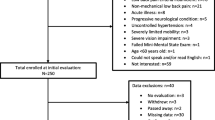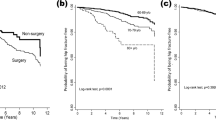Abstract
Purpose
Patients with dysplastic hip osteo arthritis (DHOA) often have a spinopelvic imbalance, and they are more likely to experience falls. This study aimed to evaluate the risk factors for falls in patients with DHOA, including spinopelvic parameters.
Methods
In this cross-sectional study, a total of 103 patients with DHOA were included from 2019 to 2021. Fall risk was evaluated using the Fall Risk Index 5 items version (FRI-5). Demographics, functional outcomes, and spinopelvic parameters were compared between the high-risk group (FRI-5 ≥ 6) and the low-risk group (FRI-5 < 6). Multivariate analysis was performed using factors with significant differences in univariate analysis.
Results
High-risk and low-risk groups comprised 54 and 49 patients, respectively. Females were significantly more common in the high-risk group than in the low-risk group. The Harris Hip Score was significantly lower in the high-risk group than in the low-risk group (p = 0.02). Pelvic incidence, tilt, and obliquity were significantly higher in the high-risk group than in the low-risk group (p < 0.01). In multivariate analysis, female sex (odds ratio [OR]: 3.76, 95% confidence interval [CI]: 1.11-12.64, p = 0.03), pelvic obliquity (OR: 1.36, 95% CI: 1.09-1.71, p < 0.01), and Harris hip score (OR: 0.96, 95% CI: 0.93-0.99, p = 0.02) were identified as risk factors.
Conclusion
Female sex, pelvic obliquity, and low Harris hip score were associated with an increased risk of falls among patients with DHOA.



Similar content being viewed by others
Data availability
Not applicable.
References
Vaapio SS, Salminen MJ, Ojanlatva A, Kivelä SL (2009) Quality of life as an outcome of fall prevention interventions among the aged: a systematic review. Eur J Public Health 19(1):7–15. https://doi.org/10.1093/eurpub/ckn099
No authors listed. American Geriatrics Society, British Geriatrics Society, American Academy of Orthopedic Surgeons Panel on Falls Prevention (2001) Guideline for the prevention of falls in older persons. J Am Geriatr Soc 49(5):664–672. https://doi.org/10.1046/j.1532-5415.2001.49115.x
Fu M, Zhou H, Li Y, Jin H, Liu X (2022) Global, regional, and national burdens of hip osteoarthritis from 1990 to 2019: estimates from the 2019 Global Burden of Disease Study. Arthritis Res Ther 24(1):8. https://doi.org/10.1186/s13075-021-02705-6
Knox PJ, Coyle PC, Pugliese JM et al (2021) Hip osteoarthritis signs and symptoms are associated with increased fall risk among community-dwelling older adults with chronic low back pain: a prospective study. Arthritis Res Ther 23(1):71. https://doi.org/10.1186/s13075-021-02455-5
Ikutomo H, Nagai K, Tagomori K et al (2019) Incidence and risk factors for falls in women with end-stage hip osteoarthritis. J Geriatr Phys Ther 42(3):161–166. https://doi.org/10.1519/JPT.0000000000000156
Campbell AJ, Borrie MJ, Spears GF (1989) Risk factors for falls in a community-based prospective study of people 70 years and older. J Gerontol 44(4):M112–M117. https://doi.org/10.1093/geronj/44.4.m112
Attiah M, Gaonkar B, Alkhalid Y et al (2019) Natural history of the aging spine: a cross-sectional analysis of spinopelvic parameters in the asymptomatic population. J Neurosurg Spine 27:1–6. https://doi.org/10.3171/2019.7.SPINE181164
Le Huec JC, Aunoble S, Philippe L, Nicolas P (2011) Pelvic parameters: origin and significance. Eur Spine J 20(5):564–571. https://doi.org/10.1007/s00586-011-1940-1
Imagama S, Ito Z, Wakao N et al (2013) Influence of spinal sagittal alignment, body balance, muscle strength, and physical ability on falling of middle-aged and elderly males. Eur Spine J 22(6):1346–1353. https://doi.org/10.1007/s00586-013-2721-9
Takemoto G, Osawa Y, Seki T et al (2022) Factors influencing inconsistent leg length discrepancy in dysplastic hip osteoarthritis: a retrospective study. BMC Musculoskelet Disord 23(1):381. https://doi.org/10.1186/s12891-022-05348-z
Cahanin Iv RL, Jefferson JR, Flynn TW et al (2019) Iliac crest height difference and other running-related variables’ relationship with running injury. Int J Sports Phys Ther 14(6):957–966
Pratelli E, Alito A, Zanella C et al (2017) Lower limbs heterometry correction in patients with osteoporosis and increased risk of falls. Clin Cases Miner Bone Metab 14(3):294–297. https://doi.org/10.11138/ccmbm/2017.14.3.294
Okuda T, Fujita T, Kaneuji A et al (2007) Stage-specific sagittal spinopelvic alignment changes in osteoarthritis of the hip secondary to developmental hip dysplasia. Spine 32(26):E816–E819. https://doi.org/10.1097/BRS.0b013e31815ce695
Okochi J, Toba K, Takahashi T et al (2006) Simple screening test for risk of falls in the elderly. Geriatr Gerontol Int 6(4):223–227. https://doi.org/10.1111/j.1447-0594.2006.00352.x
Yoshimoto H, Sato S, Masuda T et al (2005) Spinopelvic alignment in patients with osteoarthrosis of the hip: a radiographic comparison to patients with low back pain. Spine 30(14):1650–1657. https://doi.org/10.1097/01.brs.0000169446.69758.fa
Lecoanet P, Vargas M, Pallaro J et al (2018) Leg length discrepancy after total hip arthroplasty: can leg length be satisfactorily controlled via anterior approach without a traction table? Evaluation in 56 patients with EOS 3D. Orthop Traumatol Surg Res. 104(8):1143–1148
Wu PK, Lin YM (2010) In brief: Crowe’s classification: arthroplasty in developmental dysplasia of the hip. Clin Orthop Relat Res 468(12):3426; author reply 3427. https://doi.org/10.1007/s11999-010-1599-7
Kellgren JH, Lawrence JS (1957) Radiological assessment of osteo-arthrosis. Ann Rheum Dis 16(4):494–502. https://doi.org/10.1136/ard.16.4.494
Morozumi M, Ando K, Kobayashi K et al (2020) Relationship between lumbopelvic discordance and locomotive syndrome in a middle-aged community-living population: the Yakumo study. J Orthop Sci 25(4):693–699. https://doi.org/10.1016/j.jos.2019.09.016
Kanda Y (2013) Investigation of the freely available easy-to-use software ‘EZR’ for medical statistics. Bone Marrow Transplant 48(3):452–458. https://doi.org/10.1038/bmt.2012.244
Queen RM, Schmitt D (2021) Sex-specific difference in dynamic balance following total hip replacement. Innov. Aging 5(2):igab019. https://doi.org/10.1093/geroni/igab019
Chen L, Wu Y, Chen Z et al (2022) What happens to the gluteus medius in young and middle-aged patients with hip dysplasia? Int Orthop 46(4):761–768. https://doi.org/10.1007/s00264-021-05271-3
Sinaki M, Nwaogwugwu NC, Phillips BE, Mokri MP (2001) Effect of gender, age, and anthropometry on axial and appendicular muscle strength. Am J Phys Med Rehabil 80(5):330–338. https://doi.org/10.1097/00002060-200105000-00002
Munch T, Harrison SL, Barrett-Connor E et al (2015) Pain and falls and fractures in community-dwelling older men. Age Ageing 44(6):973–979. https://doi.org/10.1093/ageing/afv125
Iversen MD, Chudasama N, Losina E, Katz JN (2011) Influence of self-reported limb length discrepancy on function and satisfaction 6 years after total hip replacement. J Geriatr Phys Ther 34(3):148–152. https://doi.org/10.1519/JPT.0b013e31820e16dc
Muraki S, Akune T, Oka H et al (2013) Physical performance, bone and joint diseases, and incidence of falls in Japanese men and women: a longitudinal cohort study. Osteoporos Int 24(2):459–466. https://doi.org/10.1007/s00198-012-1967-0
Levinger P, Wallman S, Hill K (2012) Balance dysfunction and falls in people with lower limb arthritis: factors contributing to risk and effectiveness of exercise interventions. Eur Rev Aging Phys Act 9(1):17–25. https://doi.org/10.1007/s11556-011-0086-9
Arnold CM, Faulkner RA (2007) The history of falls and the association of the timed up and go test to falls and near-falls in older adults with hip osteoarthritis. BMC Geriatr 7:17. https://doi.org/10.1186/1471-2318-7-17
Beaupré P, da Silva RA, Chevrette T (2022) The impact of pain on functionality, postural control and fall risk in woman aged 45 to 64 years old. Geriatrics (Basel) 7(1):10. https://doi.org/10.3390/geriatrics7010010
Radcliff KE, Orozco F, Molby N et al (2013) Is pelvic obliquity related to degenerative scoliosis? Orthop Surg 5(3):171–176. https://doi.org/10.1111/os.12055
Yu Y, Song K, Wu B et al (2023) Coronal compensation mechanism of pelvic obliquity in patients with developmental dysplasia of the hip. Global Spine J 13(4):949–953. https://doi.org/10.1177/21925682211010760
Abe Y, Sato S, Abe S, Masuda T, Yamada K (2015) The impact of the leg-lengthening total hip arthroplasty on the coronal alignment of the spine. Scoliosis 10(S2):4. https://doi.org/10.1186/1748-7161-10-S2-S4
Ishikawa Y, Miyakoshi N, Hongo M et al (2017) Relationships among spinal mobility and sagittal alignment of spine and lower extremity to quality of life and risk of falls. Gait Posture 53:98–103. https://doi.org/10.1016/j.gaitpost.2017.01.011
Cha E, Park JH (2022) Spinopelvic alignment as a risk factor for poor balance function in low back pain patients. Global. Spine J:21925682221076417. https://doi.org/10.1177/21925682221076417
Osawa Y, Seki T, Takegami Y et al (2023) Factors affecting sports participation after total hip arthroplasty. Int Orthop 47(5):1181–1187. https://doi.org/10.1007/s00264-023-05724-x
Lazennec JY, Pour AE (2023) Patient perception of leg length after total hip arthroplasty does not correlate with sagittal lumbar spine stiffness, history of spinal pathology or fusion. Int Orthop 47(8):2041–2053. https://doi.org/10.1007/s00264-023-05810-0
Yun HH, Kim YB, Joo HJ, Koh YY (2022) Does spinopelvic motion change after total hip arthroplasty? Int Orthop 46(10):2181–2187. https://doi.org/10.1007/s00264-022-05486-y
Borgeaud T, Le Huec JC, Faundez A (2022) Pelvic and spinal postural changes between standing-sitting positions following lumbosacral fusion: a pilot study. Int Orthop 46(8):1839–1846. https://doi.org/10.1007/s00264-022-05365-6
Author information
Authors and Affiliations
Contributions
T Asamoto: data collection, study design, writing the paper
Y. Osawa: study design, data collection, data analysis
Y. Takegami: data collection, statistical analysis
M Okamoto: data collection
H Iida: data collection
S. Imagama: proofreading of the final paper
Corresponding author
Ethics declarations
Ethics approval
This investigational protocol was conducted with the approval of the Nagoya University Graduate School of Medicine Ethics Committee. In accordance with the requirements of this review, all subjects provided informed consent.
Consent to participate
Not applicable.
Consent for publication
Not applicable.
Conflicts of interest
The authors declare no competing interests.
Additional information
Publisher’s note
Springer Nature remains neutral with regard to jurisdictional claims in published maps and institutional affiliations.
Rights and permissions
Springer Nature or its licensor (e.g. a society or other partner) holds exclusive rights to this article under a publishing agreement with the author(s) or other rightsholder(s); author self-archiving of the accepted manuscript version of this article is solely governed by the terms of such publishing agreement and applicable law.
About this article
Cite this article
Asamoto, T., Osawa, Y., Takegami, Y. et al. Fall risk in patient with dysplastic hip osteoarthritis. International Orthopaedics (SICOT) 48, 221–227 (2024). https://doi.org/10.1007/s00264-023-05938-z
Received:
Accepted:
Published:
Issue Date:
DOI: https://doi.org/10.1007/s00264-023-05938-z




